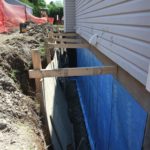Pile is a long rod immersed in soil, owning a ready form or made directly in the ground. It is intended for the pressure transmission of a basis construction on the ground. The need for this foundation occurs when upper soil layers are weak, low-strong and highly compressible. So such rods are not very suitable for small basis without improving soil properties. They transmit loads from a construction itself to low soil layers, which tend to be more durable and compacted. Let’s consider different types of pile foundation for complete understanding its benefits and purposes.
Different facts that influence on the basement classification
- used materials in their production;
- manufacture method;
- placing depth (short and long);
- cross-sectional shape and longitudinal sections;
- method of ground penetration.
Location ways:
- under free-standing pillars;
- in ribbon shapes, under building walls in one or more rows;
- in bush forms, under each column. Such an arrangement is used in the case of a frame structure.
The complete classification
This kind of basement can be:
- Basis on hanging piles. This design is more complex in calculations. Its technique requires a large number of rods. After hammering they are cut off with tops, the construction is enhanced by mounting the precast concrete tip. The resulting cavity between a head part and rod is poured concrete. The load on pillars is transmitted through grillage. It is performed under the load-bearing walls in the form of cross beams. To strength a basis you may place two rod rows.
- Basis on retaining piles. Rod-racks must have a wide base. They are immersed until solid soil layers depth. This type of basis is used in the private house construction.
Manufacturing influence on classification
 According to used materials for manufacturing piles can be:
According to used materials for manufacturing piles can be:
- Wood. They are among the first ones and fairly well established, though in contrast to other materials, but still the most short-lived.
- Reinforced concrete – a reinforcing cage, poured with concrete solution. The following details are usually made from 10 to 40 ft in length. They are the most popular nowadays.
- Concrete. They do not have the reinforcing cage along the entire length, but their top still needs reinforcement. There are also popular rods of rubble concrete. It used about 30% of quarry stone for their production.
- Metal – details formed in a circular or square shape.
There are cases where materials are combined with each other. For example, metal screw rods are filled up with concrete or wooden ones are stuffed with metal screw cap.
Ground penetration and installation way influence on classification
According to method of ground penetration:
- Hammering. A cap in placed to protect against destruction of hammer blows at the upper rod end. To soften blows on metal caps use pads made of wood or rubber. Hammering is difficult to carry out through the dense layers of dry sand. In these soils it is advisable to apply undermining beneath a lower rod end.
- Vibro. It is used by immersion in thick water-saturated sands. The action of vibro engine makes oscillatory movements and soil under this influence liquefies and pile plunges with a sharp decrease friction on its side surface. After the cessation of vibro friction is completely restored.
 Pushing. It is used where the immersion with dynamic influences can not be used. Such conditions occur when pile bases installation is located near existing buildings, especially with the presence of some sand and sandy loam, that can be condensed under vibration effects. Sometimes this method is used for penetration in subsidence loess soils.
Pushing. It is used where the immersion with dynamic influences can not be used. Such conditions occur when pile bases installation is located near existing buildings, especially with the presence of some sand and sandy loam, that can be condensed under vibration effects. Sometimes this method is used for penetration in subsidence loess soils.- Screwing. It allows you to transfer the pressure on a foundation for the ground through helical blades with a diameter up to 6 ft. These details are appropriate when there is weak and low compressibility ground on the plot surface. Screwing process is used for bridge piers, foundations, masts, towers, poles of power transmission lines. These screwing details can be incorporated into any soil, except clay soils with fluid consistency, as well as silts and peaty ground.
According to installation design method:
- Basis with headlocks. Screwing piles are twisted by markup, cut off at the level, set with headlocks on top and scald. This type is perfect for log houses, houses of basalt slabs, frame-panel houses and other lightweight structures.
- Grillage basis. Screwing details are twisted by markup, connected by reinforcement framework, formwork is installed and poured with concrete.
- Basis with strapping by channel bar. After screwing details by markup, the channel bar is mounted on top and scald. In some instances, people use additional structures to increase base strength.
The mounting process of pile foundations is always carried out strictly according to the marking in accordance with the whole project. To twist these details, use special machinery – anchor truck, as only mechanized twist allows you to securely fasten such details in ground at the predicted depth with minimal deviations in vertical and horizontal plane.




